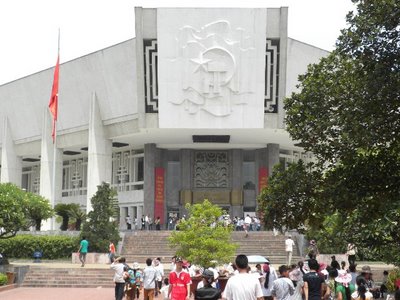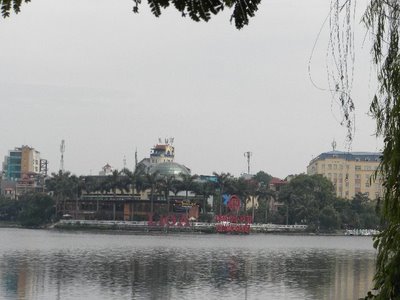I was glad to be taking a group tour this time. In Saigon we splurged
on what we viewed as the luxury of a private driver so that we could be
flexible in what we saw and how long we stayed. But what we realized on
the cruise was that it was nice meeting other travelers from various
parts of the globe who all had an interesting story to tell. It made
being shuttled about from place to place that much more interesting.
The
tour begins by chasing around the city picking up all the different
people at their hotel. For some reason we had to circle the block a
couple of times for this one hotel. Apparently no legal place to park.
On the 3rd try the driver must have said "screw it" and parked anyway.
So the guide goes in to look for the people he's supposed to be picking
up and what happens but the paddy-wagon pulls up. The driver gets
yanked out of our little bus and hauled off. Of course all this flap is
happening in rapid Vietnamese so no one had any idea what was going on.
The tour guide gets back with the people but now he has to find the
driver. I thought they were going to haul him into the paddywagon but I
guess there was a place nearby where he either paid his fine or paid
someone off. Before long we were back on the road.
The tour we
chose (well, we really didn't "choose" it, it's the only tour our hotel
offered on Tues) focused on Ho Chi MInh and his residential "complex" in
the morning. Our first stop was high security - a visit to view his
body on display in his mausoleum. The tour guide (this one named Duong -
pronounced Yung - same as the guide in Saigon) collected our cameras -
no photos of the esteemed Uncle Ho, please - and said he'd meet us at
the other end of the building. I don't know how they've managed to
keep Ho looking so good after 35 or more years, although the lights were
dim. (Duong, apparently not a big fan of the government, told us that
every year during Oct/Nov Uncle Ho's body is shipped back to Russia to
get "re-freshed" so the mausoleum is closed). Everyone entering the
mausoleum is required to be covered to the knee and over the shoulders
which caused a little consternation for some people who hadn't read
their guidebooks. One old guy on the tour got totally agitated. I
don't know what his problem was but he stormed off and said he'd make
his way back to wherever he thought the tour was going. Had no interest
in Ho Chi Minh, I guess. Our tour guide chased after him and tried to
placate him, coming back only after the guy agreed to meet us in 2 hours
when we finished the Ho leg of this journey. Poor Duong. The day
isn't starting out so good for him. First the driver, and now this
kook, to say nothing of the old Australian grandmother who didn't read
the guidebook and has shorts and bare shoulders and is bitching that
she's not buying a shawl to cover herself. I'm not sure how that got
resolved but eventually it did and she shut up. We also had to leave
all our backpacks, pocketbooks, etc on the bus. Any wonder why the guy
wants to meet us on the other side of the building. He's not taking any
chances passing armed guards with this lot.
 Ho Chi Minh Mausoleum
Ho Chi Minh MausoleumThe line snaked for
what seemed like miles but we were able to cut in since we were part of
the privileged tourist scene. Guards everywhere. We entered the
windowless mausoleum and ascended the steps and there he lay in all his
glory in the dimmest of lights but dressed to the nines, his whispy grey
hair and beard combed ever so nicely, armed guards in their crisp white
uniforms on all four corners of his glass viewing case. There's no
time to stop & gawk, no talking allowed, maintain decorum at all
times, show respect, just catch a view on 3 of 4 sides and keep moving.
We were back out in the heat & humidity in no time.
We
viewed the Presidential Palace from outside. Built in 1906, this french
colonial mansion was built by the French for the Governor General of
Indochina during their occupation. It was incredibly beautiful and is
now used for government for ceremonial receptions. Our next stop was
the garage where a number of old cars belonging to Ho, I guess, were
housed. He sure drove around in style. Of particular interest was an
old Soviet-manufactured model. The house Ho lived in during the
mid-1950s til about 1969 was next, a small sparsely furnished building
on stilts adjacent to a pond amidst a beautiful garden. Nearby was the
One Pillar Pagoda, built in 1049 by Emperor Ly Thai Tong in appreciation
for the birth of the son he feared he'd never have. We passed the
obligatory food and souvenir & food stalls where we agreed to meet
after seeing the Ho Chi Minh Museum. I have to say, I was extremely
surprised and impressed with this museum which glorifies all of Ho Chi
Minh's accomplishments - of which there are countless.
 Outside Ho Chi Minh Museum
Outside Ho Chi Minh MuseumFor
those of you who don't know, he had a very long career. Founder of the
Vietnamese Communist Party, he was later President of the Democratic
Republic of Vietnam from 1946 until his death in 1969. He left VN as a
cook's apprentice on a French ship in 1911 at the age of 21 and sailed
to North America, Africa and Europe. He spent time in Europe,
eventually settling in Paris where he learned to fluently speak not only
French but English, German and Mandarin as well. His involvement in
the establishment of the French Communist Party led to training in
Moscow and eventually China. He spent much of his adult life fighting
on behalf of the Vietnamese peasant, against the Chinese, the Japanese,
the French and eventually the Americans. He never lived to see the
Americans expelled from his country but he inspired his followers to
insure that Vietnam would someday be free of foreign rule.
The
museum was very interactive and the exhibitions engaging. This is when I
wished I wasn't on a tour. And Kelly agreed, we could have spent
considerably more time than the 1/2 hour we were allotted to really take
in everything that was here. But we had to move on and meet back up
with the group.
Our next stop was the Temple of Literature, site
of the country's first college, dedicated to Confucian. The grounds and
the buildings were beautiful however I don't recall much more. It's
all starting to look the same.
By this time, Kelly and I have
latched onto two young boys from Holland on the tour who are in transit
between scuba diving in Bali before heading onward to Thailand. They
wanted to make sure their mothers knew they were doing more than just
drinking, partying and diving and thought this tour was a great
diversion. We sat together when we stopped for lunch at a small
traditional Vietnamese restaurant. The food was quite good and the boys
imbibed on green coconut water in addition to the local beer. No pho
here but the usual white rice, some stirfried vegetables, some chicken
with noodle, nothing too memorable.
Next stop: Tran Quoc Pagoda
on the shores of West Lake. It was a typical beautiful pagoda but by
now Duong's English is getting a little incomprehensible. The only
thing I do recall was that the lake was the site of the downing of John
McCain's plane. Duong explained that the Hoa Lo Prison, better known as
the "Hanoi Hilton" where McCain was imprisoned, was near our next stop
if anyone wanted to depart the tour and divert on their own to see it.
Kelly & I decided we would.
 The West Lake
The West LakeBut off to the Ethnology Museum
first: a rather interesting place that highlights the many ethnic groups
that comprise the country. Exhibits feature the dress and crafts of
the various enthnicities as well as some history on the culture and an
outdoor area featuring lifesize samples of the various houses built by
these groups. By this time the heat was really getting oppressive and
it was getting difficult to concentrate. We were fading fast.
We
said out good-byes just outside the Hanoi Hilton and headed inside.
The prison was actually built by the French to house all the
revolutionaries who tried to oust their colonial masters starting in
1896. Only about 1/4 of the original prison - one long corridor of what
had been an obtuse square covering an entire city block - remains. But
it gave us enough of an impression of the dire circumstances both the
Vietnamese, and later the Americans, had to endure. Most of the
exhibits focused on Vietnamese prisoners. Originally designed to hold
about 450 inmates, there were actually almost 2000 prisoners crammed in
there during the revolutionary agitations of the 1930s. A huge office
or residential tower skyscraper is now residing where much of the prison
once stood, another testament to the constant development going on in
this country. The worst of the exhibits was a French guillotine used to
behead the worst of the Vietnamese revolutionaries. Only one small
exhibit relates to the Americans. McCain's flight suit and helmet is
there and some old film footage of American bombings as well as some
interesting propaganda showing the American prisoners making Christmas
decorations and decorating a Christmas tree.
Our hotel was surprisingly not very far from the prison and we made it back in about 15 minutes.
To be continued...Source: http://www.traveljournals.net